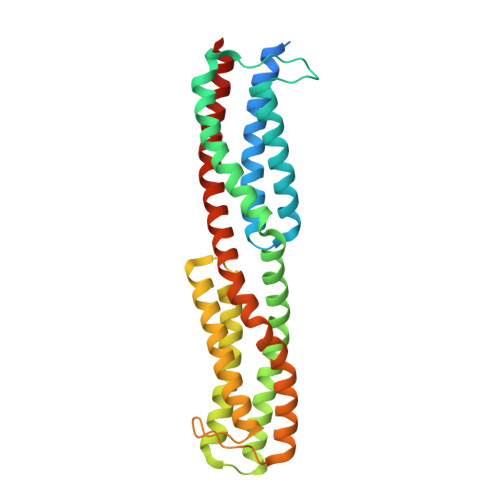The ligand binding domain of a type IV pilus chemoreceptor PilJ has a different fold from that of another PilJ-type receptor McpN.
Cui, R., Wang, Q.A., Guo, L., Li, D.F.(2024) Biochem Biophys Res Commun 706: 149765-149765
- PubMed: 38484573
- DOI: https://doi.org/10.1016/j.bbrc.2024.149765
- Primary Citation of Related Structures:
8WDF - PubMed Abstract:
Bacterial chemoreceptors sense the extracellular signals and regulate bacterial motilities, biofilm formation, etc. The periplasmic ligand binding domains of chemoreceptors occur as different structural folds and recognize a diversity of chemical molecules. In Pseudomonas aeruginosa (PAO1), two bacterial chemoreceptors, McpN (PA2788) and PilJ (PA0411), are proposed to both contain a PilJ-like ligand-binding domain (LBD) (Pfam motif PF13675) and involved in nitrate chemotaxis and type IV pilus-mediated motility, respectively. The LBDs of McpN and PilJ consist of 135 and 263 residues, respectively, and share very low sequence identity, suggesting they might occur as different structures. Here, we found that PilJ-LBD folded into an HBM module, the same as the sensor domains of McpS-LBD and TorS-LBD, but it differed from that of McpN-LBD. We also observed a trimer in SEC and AUC and proposed a trimeric model based on the crystal structure. Based on the sequence, we classified the Pfam containing McpN-LBD and PilJ-LBD into three classes: sPilJ (single PilJ) represented by McpN-LBD with only one PilJ domain, dPilJ (dual PilJ) that contained dual PilJ domains, and hPilJ (hybrid PilJ) that comprises of a PilJ domain and another non-PilJ domain. Our work indicates a significant structural difference between the ligand binding domains of PilJ and McpN and will help our further study on both kinds of chemoreceptors.
- State Key Laboratory of Microbial Resources, Institute of Microbiology, Chinese Academy of Sciences, Beijing, 100101, PR China; School of Life Sciences, University of Chinese Academy of Sciences, Beijing, 100049, PR China.
Organizational Affiliation:
















